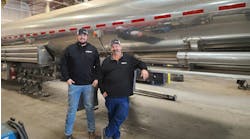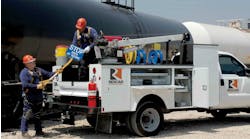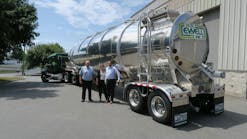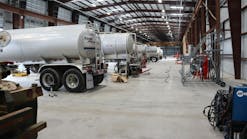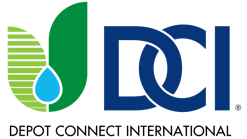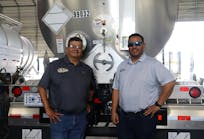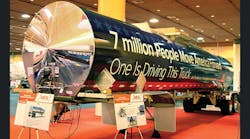FMCSA intensifying its focus on cargo tank manufacturing, inspection, repair
THE Federal Motor Carrier Safety Administration (FMCSA) has been taking a harder look at cargo tank manufacturing, inspection, and repair facilities since January 2015. And based on what it has found, FMCSA plans to intensify its scrutiny.
Paul Bomgardner, chief of the FMCSA’s Hazardous Materials Division, discussed the reasons for the increased focus on cargo tank repair facilities during National Tank Truck Carriers’ 2016 Tank Truck Week in New Orleans, Louisiana.
“It’s pretty disturbing, when you think of what a cargo tank manufacturer is building,” he said. “You’re building one of the biggest packages that has hazmat in it. The exposure is enormous. Cargo tanks need to be built right. They need to have the protection that the regulations call for—the rollover protection that’s specified, the pressure-relief devices that are proper.
“We’ve been finding things wrong with brand new tanks with those types of defects on them. I can tell you that our focus at FMCSA will remain on the cargo tank manufacturing, inspection, and repair industry for the near future.”
He listed the top 25 cargo tank manufacturing facility violations, in order of the most prevalent:
• § 172.704(a) Training requirements: general awareness/familiarization, function-specific, safety and or security awareness training; no hazardous materials employee training as required.
• § 172.704(d) Recordkeeping: insufficient training records or no training records.
• § 171.8 Design Certifying Engineer: unqualified design certifying engineers.
• § 171.8 Registered Inspector: unqualified registered inspectors.
• § 178.345-8(c)(1) Accident damage protection: failing to meet applicable specifications, such as the overturn protection not meeting the required strength.
• § 178.345-8(b)(1) Accident damage protection: rear-end protection not rated at 155,000 pounds when the piping is located in the lower one-third circumference of the tank.
• § 178.345-8(c) Accident damage protection: items extending outside of the overturn protection.
• § 178.345-8 (d)(2)(ii) Accident damage protection: tanks with split rear end protection not having the required sacrificial device outboard of a shut-off valve.
• § 178.345-8(a)(3) Accident damage protection: improper methods of attachment of the accident damage protection devices.
• § 178.345-8(d)(1) Accident damage protection: the rear-end cargo tank protection device must was not designed to deflect at least six inches horizontally.
• § 178.345-3(f)(3), § 178.337-3(f)(3), and § 178.3338-3(f)(3): not using mounting pads when welding appurtenances to the wall of the cargo tank and/or not extending at least two inches in each direction from any point of the appurtenance or attachment.
• § 178.337-3(a)(l), l78.345-3(a)(l), and 178.338-3(a)(l) Structural integrity, general requirements and acceptance criteria: not manufacturing to a design margin of 4:1 as required. The maximum calculated design stress at any point in the cargo tank wall may not exceed the maximum allowable stress value prescribed in Section VIII of the ASME Code (IBR, see §171.7 of this subchapter), or 25% of the tensile strength of the material used at design conditions.
• § 178.345-15 (b)(1) and (c)(1) Certification: not designed or signed by a Design Certifying Engineer (DCE).
• § 178.345-1 General requirements: not constructed and certified in conformance with the ASME Code.
• § 178.345-4 Joints: welds not in conformance with Section VIII of the ASME Code; insufficient weld material, welding on contaminated (dirt, rust, etc.) material.
• § 178.345-10 Pressure Relief and Venting: insufficient venting per surface area.
• § 178.337-9(b)(6) Piping, Valves, Hose, and Fittings: cargo tank manufacturers and fabricators failed to demonstrate that all piping, valves, and fittings on a cargo tank are free from leaks.
• § 178.345-5 Manhole Assemblies: not meeting labeling and or certification requirements.
• § 178.346-5 Pressure and leakage tests: incorrectly performing hydrostatic or pneumatic test.
• § 178.337-4(b), § 178.338-4 Joints: welding procedure and or welder performance not in accordance with Section IX of the ASME Code.
• § 178.338-16 Inspection and testing: welder and or welding procedure are not qualified or followed in accordance with Section IX of ASME.
• § 178.320(b) General requirements applicable to all DOT specification cargo tank motor vehicles.
• § 178.345-14 Marking: (b) name plate and (c) specification plate—incorrect or missing required information.
• § 178.345-7(c) Circumferential reinforcements: not in conformance when using baffles or baffle attachments as part of reinforcement.
• § 178.345-7 (d) Circumferential reinforcements: ring stiffener used as a circumferential reinforcement member not continuous around the circumference of the cargo tank shell.
These observed problems have prompted FMCSA to issue some safety alerts:
• Fatalities associated with hot work on tankers: recognizing and understanding the job/hazards and the following of safe work practices can prevent potential fires, explosions, and health hazards.
• Fisher PRD safety recall: pressure relief devices (PRD) that were not manufactured or intended for use on cargo tank motor vehicles. PRDs are an integral part of the safety mechanisms for US Department of Transportation (DOT) specification cargo tank motor vehicles and are vital to ensuring the safety of hazardous materials transportation by highway.
• Immediate testing and repair of certain TYTAL cargo tanks: provides notice to owners and operators of TYTAL cargo tank motor vehicles (CTMVs) with a capacity of 8400, 8717, and 10,500 gallons and primarily used for the transportation of petroleum crude oil, UN1267. These CTMVs are not in compliance with the Federal Hazardous Materials Regulations (HMRs) and do not meet the DOT 407.
• Immediate re-inspection and retesting of certain cargo tank motor vehicles required: to provide notice to owners and operators of certain cargo tanks that they have been improperly inspected and tested, and must be re-inspected and retested before being used in Hazardous Materials specification tank service. The tanks in question were tested by H&W Tank Testing, CT#8083, Ohatchee, Alabama, and Christopher Humphries, CT#13131, Jacksonville, Alabama. Cargo tanks that have been inspected and/or tested by either company from April 2011 through March 2016, must be re-inspected and/or retested in accordance with 49 CFR § 180.407 immediately by a cargo tank facility registered with FMCSA.
Bomgardner provided this information on hazardous materials route registry:
• § 397.67(b): Placarded or marked hazardous materials not subject to NRHM routing designations, shall be transported over routes which do not go through or near heavily populated areas, places where crowds are assembled, tunnels, narrow streets, or alleys.
• § 397.73(b): Each state or Indian tribe, through its routing agency, shall provide information identifying all NRHM routing designations that exist within its jurisdiction to the FMCSA. States shall also submit: the current name of the state agency responsible for NHRM highway routing designations; descriptions of the routing designations; the dates they were established; and information on any subsequent changes or new NRHM routing designations within 60 days after establishment. This information will be available from the FMCSA, consolidated by the FMCSA, and published annually in whole or as updates in the Federal Register. A state or tribally designated route is effective only after it is published in the Federal Register in FMCSA’s Hazardous Materials Route Registry.
• § 397.101(b): A motor vehicle containing a highway route controlled quantity (HRCQ) of Class 7 materials, shall be operated over preferred routes: an interstate system highway for which an alternative route is not designated by a State routing agency; and a designated route selected by a state routing agency.
• § 397.103(c) A state-designated route is effective when: the state gives written notice to the FMCSA; receipt thereof is acknowledged by the FMCSA; and rhe route is published in FMCSA’s Hazardous Materials Route Registry.
He also provided a preview of changes in the Compliance, Safety, Accountability program’s Safety Management System (SMS):
“We know that strong, reliable data means smarter safety decisions—and ultimately safer roads for everyone,” he said. “This is why we recently proposed enhancements to the SMS that put our latest analysis and your input to work to more effectively prioritize and intervene with carriers that post the greatest safety risk.”
• Objective 1: Make the SMS more effective at prioritizing carriers that pose the greatest safety risk for interventions by: expanding the range over which the Utilization Factor is applied; simplifying the data sufficiency standards by only assigning BASIC percentiles to companies that have had an inspection with a violation in the past year; and segmenting the Hazardous Materials (HM) Compliance BASIC by cargo tank and non-cargo tank operations.
• Objective 2: Improve FMCSA’s focus on carriers with high crash rates and serious safety problems by: adjusting the Intervention Thresholds for the Vehicle Maintenance, Controlled Substances/Alcohol, Driver Fitness, and HM Compliance BASICs; and moving all operating while out-of-service (OOS) violations to the Unsafe Driving BASIC.
• Objective 3: Prioritize FMCSA’s investigative resources on carriers with more crash involvement by: increasing the number of crashes required to assign a percentile in the Crash Indicator BASIC from two to three. ♦
